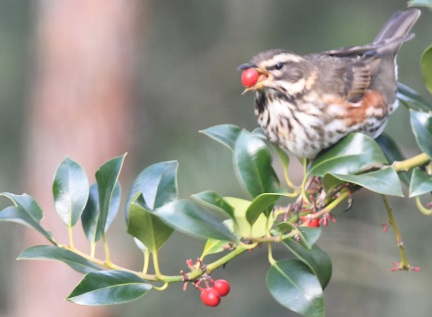Nature Notes December 2019
Date Published: 05-01-2020
December was a mostly a wet month, with only a few dry days.
SIGHTINGS
Birds (seen or heard) : Carrion Crows, Magpies, Jays, Buzzards, Sparrowhawk, Green/Great Spotted Woodpeckers, Grey Heron, Wood Pigeons, Stock Doves, Nuthatches, Treecreepers, Wrens, Goldcrest, Firecrest, Redwings, Blackbirds, Song Thrushes, Robins, Dunnocks, Greenfinches, Chaffinches, Goldfinches, Bullfinches, Siskins, Stonechats, Coal/Blue/Great/Long-tailed Tits.
Mammals: Grey Squirrels, Mole activity.
Insects/Spiders: Midges, Bees.
Plants in flower/berries: Rowan, Holly, Ivy.
Fungi: Sulphur Tuft.
A quiet month on the Reserve, with not a great deal of movement.
In the first week of the month, a flock of around 60 Redwings descended upon the Holly bushes, stripping them of their berries.
The bird box survey was carried out late again this year, due to the wet conditions on site. The boxes were emptied, if used, cleaned, maintained or replaced as necessary. 22 boxes were used during the breeding season.
NATURE FACT
Of our six species of Thrush, two are mainly winter visitors, the Redwing and Fieldfare. Their chief breeding grounds are in Scandinavia and Siberia. The ‘seep’ sound is the most common flight call of the Redwing. This bird is fractionally smaller than the Song Thrush. Any spell of cold weather may bring fresh hordes into Britain from across the North Sea, or the cold may cause those already here to migrate further westwards, in search of slightly warmer conditions and fresh food supplies.
Recorder: C. Wilcox





